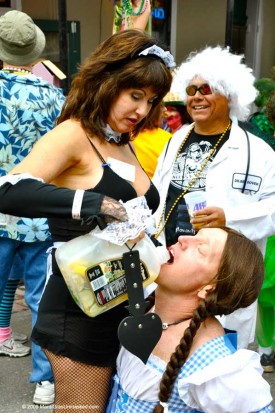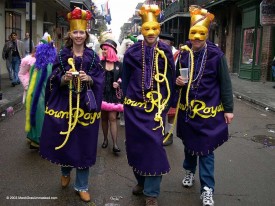Alcohol flows more freely in New Orleans than almost anywhere else in the United States, and New Orleans cops are generally tolerant of intoxicated partiers caught up in the thrall of Mardi Gras Madness. But those looking to take full advantage of the city’s famously relaxed drinking laws should somehow try to remember that tolerance has its limits and that public drunkenness is a leading cause of arrest during the festivities.
Tolerance of intoxication has its limits at the Greatest Free Show
You bring a nickel, and I’ll put a dime
Honk it together now and we can drink some wine
All because it’s Carnival time
Well, it’s Carnival time
Well it’s Carnival time
Everybody’s drinking wine
Carnival Time (words and music by Al Johnson)
Administering libations on Bourbon Street
For some revelers who take full advantage of New Orleans’ famously relaxed drinking laws, maintaining some semblance of common sense can pose a challenge.
Alcohol flows more freely in New Orleans than almost anywhere else in the United States, and it goes hand in hand with just about every aspect of Carnival — from the Champagne toasts of tinsel royalty to the “fire water” of Mardi Gras Indians to the Hurricane-soaked spectacle of Bourbon Street. Wherever you go, revelers take full advantage of the city’s famously relaxed laws that allow drinking in public year round.
No glass containers or cans are allowed on the street, however — hence the omnipresent plastic containers, known as “go-cups.” Indeed, go-cups are a New Orleans institution — and a common Mardi Gras throw.
Although many people assume that drinking to excess at Mardi Gras is perfectly acceptable, if not expected, public drunkenness is a leading cause of arrest during the festivities. If you pass out on a door stoop or on a bench, or get caught urinating in public, there’s a good chance you’ll wind up in Central Lock-up.
New Orleans cops are generally tolerant of intoxicated partiers caught up in the thrall of Mardi Gras Madness, but they’re also quick to crack down if you cross the line. So while it would be perfectly OK, in a display of mock gratitude, to bow down and prostrate yourself before a beer deliveryman in the French Quarter, climbing atop his truck and doing the hokey pokey to impress your friends would most definitely put you in jeopardy of arrest.
Simply put, a little self-control and common sense can go a long way toward staying out of trouble. Remember to fortify yourself with solid food and to use the bathroom when you buy a drink. Moreover, try to remain at least somewhat cognizant of how easy it is in the Big Easy to become over-served. Markets and drug stores sell liquor at all hours, cans of beer packed in ice beckon from gas-station bins, and some bars never close their doors. Bourbon Street boasts “Huge Ass Beers,” daiquiri bars with row upon row of slushee machines, and to-go windows offering Jell-O shots, shooters, Hurricanes and the infamous Hand Grenade, billed as “New Orleans’ Most Powerful Drink” and served in its own grenade-shaped container. The neon-green, grain alcohol-laced elixir even has its own mascot. A goofy fellow got up in an inflatable grenade costume, he merrily bobs around Bourbon Street while posing for snapshots like a cartoon character at an amusement park.
Never underestimate “just a few” when it comes to the brightly colored libations of Bourbon Street — or the hangovers that can be exacerbated by their sugary content.
Crown Royal maskers at Mardi Gras 2003
Alcohol-themed costumes are a perennial favorite at a celebration known for mass inebriation.
Of course, New Orleans’s reputation as a drinking town is built on much more than the carnivalesque atmosphere of today’s Bourbon Street, where the “culture” of Spring Break seems to reign year round. Thanks to the Sazerac, invented in the French Quarter in the 1830s, the cocktail was a Crescent City art form before the birth of jazz. Upholding the city’s rich tradition of cultured drinking, many classic haunts still serve signature cocktails: the Vieux Carré at the Carousel Bar in Hotel Monteleon; the Obituary Cocktail at Lafitte’s Blacksmith Shop; the Hurricane at Pat O’Brien’s; the Pimm’s Cup at Napoleon House; and the Sazerac and Ramos Gin Fizz at the Sazerac Bar in the Roosevelt Hotel, to name just a few. Connoisseurs of martinis can find over 125 variations at the Bombay Club Restaurant and Martini Bistro, down a carriageway at the back of the Prince Conti Hotel.
New Orleans is often called the most haunted city in America, with popular ghost tours to prove it, but spirits of the distilled variety are a tourist attraction in their own right. The city boasts an effervescent craft cocktail scene and a generous dollop of hooch heritage, including the Museum of the American Cocktail and the New Orleans Original Cocktail Tour, which takes you into wine cellars and private dining rooms of famous French Quarter establishments and promises “classic stories of the unique concoctions made famous in New Orleans and the characters that brought them to life, including Southern Comfort, created by M.W. Heron in a French Quarter bar in 1874.” Then there’s the annual Tales of the Cocktail festival, guaranteed to “stir your soul” with mixology competitions, tastings, soirées and educational infusions: seminars on topics like saloon history, Hollywood cocktails, the fine art of distillation and famous bartenders.
Just remember, during Mardi Gras, to bring plenty of drinking cash. If you whip out a credit card to pay, a busy bartender doing his frenzied best to keep the bacchanal lubricated might look at you as if to say, “Gimme a break!”
MardiGrasTraditions.com


